- Clone
- L276F12 (See other available formats)
- Regulatory Status
- RUO
- Other Names
- Fusin, LESTR, Sdf1r, Cmkar4, PB-CKR, PBSF/SDF-1
- Isotype
- Rat IgG2b, κ
- Barcode Sequence
- GTCGTGGTGTTGTTC
| Cat # | Size | Price | Quantity Check Availability | ||
|---|---|---|---|---|---|
| 146521 | 10 µg | $369.00 | |||
CD184, also known as CXCR4, is a member of the G protein coupled receptor family that binds CXCL12 (SDF1). CXCR4 and CXCL12 play an important role in immune and inflammatory responses through the regulation of cell migration and growth. CXCR4 plays a crucial role in the pathogenesis of several autoimmune diseases such as atherosclerosis, rheumatoid arthritis, and wound healing. In addition, CXCR4 is the cofactor for fusion and entry of the T cell-tropic form of HIV-1.
Product Details
- Verified Reactivity
- Mouse
- Antibody Type
- Monoclonal
- Host Species
- Rat
- Immunogen
- Mouse CXCR4-transfected cells
- Formulation
- Phosphate-buffered solution, pH 7.2, containing 0.09% sodium azide and EDTA
- Preparation
- The antibody was purified by chromatography and conjugated with TotalSeq™-B oligomer under optimal conditions.
- Concentration
- 0.5 mg/mL
- Storage & Handling
- The antibody solution should be stored undiluted between 2°C and 8°C. Do not freeze.
- Application
-
PG - Quality tested
- Recommended Usage
-
Each lot of this antibody is quality control tested by immunofluorescent staining with flow cytometric analysis and the oligomer sequence is confirmed by sequencing. TotalSeq™-B antibodies are compatible with 10x Genomics Single Cell Gene Expression Solutions.
To maximize performance, it is strongly recommended that the reagent be titrated for each application, and that you centrifuge the antibody dilution before adding to the cells at 14,000xg at 2 - 8°C for 10 minutes. Carefully pipette out the liquid avoiding the bottom of the tube and add to the cell suspension. For Proteogenomics analysis, the suggested starting amount of this reagent for titration is ≤ 1.0 µg per million cells in 100 µL volume. Refer to the corresponding TotalSeq™ protocol for specific staining instructions.
Buyer is solely responsible for determining whether Buyer has all intellectual property rights that are necessary for Buyer's intended uses of the BioLegend TotalSeq™ products. For example, for any technology platform Buyer uses with TotalSeq™, it is Buyer's sole responsibility to determine whether it has all necessary third party intellectual property rights to use that platform and TotalSeq™ with that platform. - Application Notes
-
Additional reported applications (for the relevant formats) include: in vivo blocking1
- Additional Product Notes
-
TotalSeq™ reagents are designed to profile protein levels at a single cell level following an optimized protocol similar to the CITE-seq workflow. A compatible single cell device (e.g. 10x Genomics Chromium System and Reagents) and sequencer (e.g. Illumina analyzers) are required. Please contact technical support for more information, or visit biolegend.com/totalseq.
The barcode flanking sequences are GTGACTGGAGTTCAGACGTGTGCTCTTCCGATCTNNNNNNNNNN (PCR handle), and NNNNNNNNNGCTTTAAGGCCGGTCCTAGC*A*A (capture sequence). N represents either randomly selected A, C, G, or T, and * indicates a phosphorothioated bond, to prevent nuclease degradation.
View more applications data for this product in our Scientific Poster Library. -
Application References
(PubMed link indicates BioLegend citation) -
- Costa MJ, et al. 2018. PLoS One. 13:e0194688 (Block) PubMed
- RRID
-
AB_2892300 (BioLegend Cat. No. 146521)
Antigen Details
- Structure
- G-protein-coupled seven transmembrane receptor, 39.7 kD
- Distribution
-
T lymphocytes, monocytes, macrophages, tissue-committed stem/progenitor cells (TCSCs), mast cells, vascular smooth muscle cells (VSMCs)
- Function
- Development of cardiovascular and central nervous system, hematopoiesis, and colonization of BM by fetal liver-derived hematopoietic stem cells (HSCs) during embryogenesis, homing and egress of CD34+ CXCR4+ progenitor cells from bone marrow, and their migration into peripheral tissues. Critical role in homing of cancer cells to specific metastatic sites. Possible role in the ubiquitin proteosome system.
- Interaction
- Robo -1
- Ligand/Receptor
- CXCL12 (SDF-1)
- Cell Type
- Macrophages, Mast cells, Mesenchymal Stem Cells, Monocytes, Neural Stem Cells, T cells
- Biology Area
- Angiogenesis, Cell Biology, Cell Motility/Cytoskeleton/Structure, Immunology, Neuroscience, Neuroscience Cell Markers, Signal Transduction, Stem Cells, Ubiquitin/Protein Degradation
- Molecular Family
- CD Molecules, Cytokine/Chemokine Receptors, GPCR
- Antigen References
-
1. Kucia M, et al. 2005. Stem Cells 23:879.
2. Muller A, et al. 2001. Nature 410:50.
3. Saini V, et al. 2010. J. Biol. Chem. 285:15566.
4. Prasad A, et al. 2007. J. Leuko. Biol. 82:465.
5. De Klerck B, et al. 2005. Arthritis Res. Ther. 7:R1208.
6. Rueda P, et al. 2008. PLoS One 3:e2543.
7. Feng Y, et al. 1996. Science 272:872. - Gene ID
- 12767 View all products for this Gene ID
- UniProt
- View information about CD184 on UniProt.org
Other Formats
View All CD184 Reagents Request Custom Conjugation| Description | Clone | Applications |
|---|---|---|
| Purified anti-mouse CD184 (CXCR4) | L276F12 | FC |
| Alexa Fluor® 647 anti-mouse CD184 (CXCR4) | L276F12 | FC |
| PE anti-mouse CD184 (CXCR4) | L276F12 | FC |
| APC anti-mouse CD184 (CXCR4) | L276F12 | FC |
| PerCP/Cyanine5.5 anti-mouse CD184 (CXCR4) | L276F12 | FC |
| Brilliant Violet 421™ anti-mouse CD184 (CXCR4) | L276F12 | FC |
| PE/Dazzle™ 594 anti-mouse CD184 (CXCR4) | L276F12 | FC |
| Biotin anti-mouse CD184 (CXCR4) | L276F12 | FC |
| Brilliant Violet 711™ anti-mouse CD184 (CXCR4) | L276F12 | FC |
| Brilliant Violet 605™ anti-mouse CD184 (CXCR4) | L276F12 | FC |
| TotalSeq™-A0444 anti-mouse CD184 (CXCR4) | L276F12 | PG |
| TotalSeq™-B0444 anti-mouse CD184 (CXCR4) | L276F12 | PG |
| APC/Cyanine7 anti-mouse CD184 (CXCR4) Antibody | L276F12 | FC |
| TotalSeq™-C0444 anti-mouse CD184 (CXCR4) | L276F12 | PG |
| KIRAVIA Blue 520™ anti-mouse CD184 (CXCR4) | L276F12 | FC |
| Brilliant Violet 785™ anti-mouse CD184 (CXCR4) | L276F12 | FC |
| Spark Red™ 718 anti-mouse CD184 (CXCR4) Antibody | L276F12 | FC |
Compare Data Across All Formats
This data display is provided for general comparisons between formats.
Your actual data may vary due to variations in samples, target cells, instruments and their settings, staining conditions, and other factors.
If you need assistance with selecting the best format contact our expert technical support team.
-
Purified anti-mouse CD184 (CXCR4)

C57BL/6 mouse thymocytes were stained with purified CXCR4 (c... 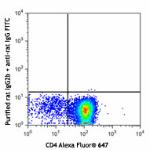
-
Alexa Fluor® 647 anti-mouse CD184 (CXCR4)
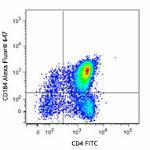
C57BL/6 mouse thymocytes were stained with CD4 FITC and CD18... 
-
PE anti-mouse CD184 (CXCR4)
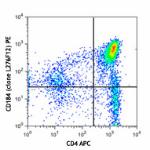
C57BL/6 mouse thymocytes were stained with CD4 APC and CD184... 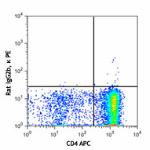
-
APC anti-mouse CD184 (CXCR4)
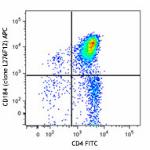
C57BL/6 mouse thymocytes were stained with CD4 FITC and CD18... 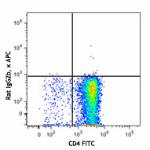
-
PerCP/Cyanine5.5 anti-mouse CD184 (CXCR4)

C57BL/6 mouse thymocytes were stained with CD4 APC and CD184... -
Brilliant Violet 421™ anti-mouse CD184 (CXCR4)
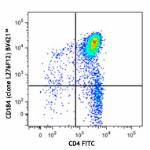
C57BL/6 mouse thymocytes were stained with CD4 FITC and CD18... 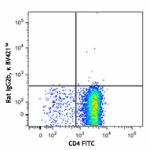
-
PE/Dazzle™ 594 anti-mouse CD184 (CXCR4)

C57BL/6 mouse thymocytes were stained with CD4 FITC and CD18... -
Biotin anti-mouse CD184 (CXCR4)
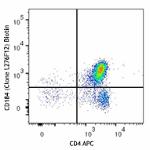
C57BL/6 mouse thymocytes were stained with biotinylated CXCR... 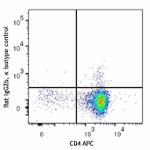
-
Brilliant Violet 711™ anti-mouse CD184 (CXCR4)
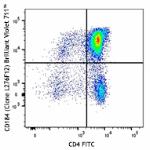
Mouse thymocytes stained with CD4 FITC and CD184 (clone L276... 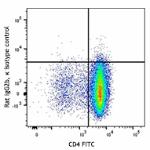
-
Brilliant Violet 605™ anti-mouse CD184 (CXCR4)
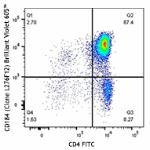
Mouse thymocytes stained with CD4 FITC and CD184 (clone L276... 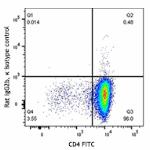
-
TotalSeq™-A0444 anti-mouse CD184 (CXCR4)
-
TotalSeq™-B0444 anti-mouse CD184 (CXCR4)
-
APC/Cyanine7 anti-mouse CD184 (CXCR4) Antibody

C57BL/6 mouse thymocytes were stained with CD4 FITC and CD18... -
TotalSeq™-C0444 anti-mouse CD184 (CXCR4)
-
KIRAVIA Blue 520™ anti-mouse CD184 (CXCR4)

C57BL/6 mouse thymocytes were stained with anti-mouse CD4 (c... -
Brilliant Violet 785™ anti-mouse CD184 (CXCR4)

C57BL/6 mouse thymocytes were stained with anti-mouse CD4 (c... -
Spark Red™ 718 anti-mouse CD184 (CXCR4) Antibody

C57BL/6 mouse thymocytes were stained with anti-mouse CD4 (c...
